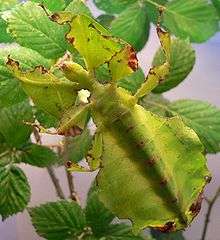Phyllium bioculatum
The Gray's leaf insect, (Phyllium (Pulchriphyllium) bioculatum),[5] is a leaf insect of the family Phylliidae native to tropical Asia as well as Madagascar, Mauritius and the Seychelles.[6] It was first described by George Robert Gray in 1832, which was his first phasmid he discovered.[7] Leaf insects have extremely flattened, irregularly shaped bodies, wings, and legs. They are usually about 5–10 cm long (2–4 in long). They are called leaf insects because their large, leathery forewings have veins that look similar to the veins on the particular type of leaves they inhabit. Its scientific name bioculatum means "two-eyed" and refers to the two dots located on the abdomen just in this species.[8]
| Phyllium bioculatum | |
|---|---|
 | |
| A female Phyllium bioculatum | |
| Scientific classification | |
| Kingdom: | |
| Phylum: | |
| Class: | |
| Order: | |
| Family: | |
| Genus: | |
| Species: | P. bioculatum |
| Binomial name | |
| Phyllium (Pulchriphyllium) bioculatum G. R. Gray, 1832 | |
| Synonyms [1][2][3][4] | |
| |
Description
The insect has green, broad body and legs and frequently has spots. Both females and males occur in shades of green, yellow, and orange.[8] Java leaf insects would be greenish or brownish as adults. Males range from 2.6 to 3.7 inches (66 to 94 mm).[1] The organism's fore wings and camouflage are used for defense. The antennae of the females are very short, while those of the male are longer. Adult females are 1.8–2.7 inches (46–69 mm) in length. The species also has hind wings which are used for flying by males, but are unused by females. Young Phyllium bioculatum are about 2 cm (0.79 in) long, dark red in colour and have reflex immobility. The species molts 5–6 times in a lifetime.[9] Females are heavy-bodied and flightless, and each lays about 500 eggs in a lifetime.[10] The abdomen is narrower at the base, and the femur of the fore legs are dilated.[11]
Ecology
They are slow-moving herbivores and rely on their camouflage and fore wings for defense from predators including birds, amphibians and reptiles.[12][13] The females live from 4 to 7 months and males from 3 weeks to 1 month.
Habitat and Distribution
These leaf insects are found mainly in tropical areas and rainforests where adequate quantities of vegetation are available for consumption. It is widespread in Southeast Asia, in Borneo, China, India, Sri Lanka, Java, Malaysia, Singapore, and Sumatra. It is also found in Madagascar, Mauritius, and the Seychelles.
The preferred temperature for this species is 24–28 °C (75–82 °F), which at night may slightly decrease by 2–3 °C (3.6–5.4 °F). Temperature does not strongly affect the species but will slow development. It is important that the temperature is not reduced below 22 °C (72 °F). Low humidity can cause stress and death.[8]
Diet
As a herbivore Phyllium bioculatum mainly eats mango, guava, Nephelium lappaceum (Rambutan), and in captivity some accept Quercus (oak) and Rubus (dewberry, raspberry and blackberry) species.
A study was done in Sri Lanka, based on the leaf insect's diet. The specimens mainly fed on guava. Accordingly, the local name for the species in Sri Lanka is pera kolaya (guava leaf). In many places they are colloquially referred to on the basis of what they eat.[14]
Reproduction and incubation
The females lay eggs in months. Incubation takes place from 5–7 months at 25 °C (77 °F). Eggs are beige-brown and about 6–7 mm (0.2–0.3 in).[15]
However, many times the eggs laid are not fertilized due to parthenogenesis. This is a form of asexual reproduction found in females, where growth and development of embryos occurs without fertilization by a male. Eggs are oval or barrel-shaped, like seeds. Different types of oviposition occur in leaf insects. The eggs of this species are catapulted by a backward movement of the abdomen.[16] In a study the ratio of the distance the egg was thrown and the body length of the insect was compared with some other species, which was 24-36.[17] If the eggs are fertilized, then it takes 3–4 months for incubation, otherwise it takes 6 months for unfertilized eggs. Unfertilized eggs hatch out with females only, while fertilized ones may be either male or female. The female lays about 100 eggs at intervals of a few days. The larvae are red at hatching but green within three to seven days. These hatch from eggs laid at a rate of three per day per female.[10]
References
Notes
- "Javan Leaf Insect".
- "Insects and Spiders". Net Industries.
- "Phyllium bioculatum". BioLib.
- "Phyllium bioculatum". ITIS. Catalogue of Life:2009 Annual Checklist.
- "Species Details : Phyllium (Pulchriphyllium) bioculatum Gray, G.R., 1832". Catalogue of Life. 13 February 2017. Retrieved 7 October 2015.
- "Phyllium bioculatum". Phasmid Study Group.
- P. E. Bragg (2007). "Biographies of Phasmatologists– 2. George Robert Gray" (PDF). Phasmid Studies. 15 (1 & 2): 5–9.
- "Phyllium bioculatum". Phyllium.yoyo.pl.
- Kalasinskas, Ron. "Java Leaf Insect". Animals of the Rainforest. Archived from the original on 2012-12-18.
- Amelia Hanibeltz; Yoko Nakamura; Alison Imms; Eva Abdullah. "The survival of newly-hatched leaf insects" (PDF). Phasmid Studies. 4 (2): 60–63.
- Edward Newman (1843). "Insects". The zoologist: a popular miscellany of natural history, volume 1. London. p. 122.
- Ch'ien C. Lee. "Stock Photograph of Phyllium bioculatum from West Java, Indonesia (cld07031002)". Retrieved June 22, 2012.
- "Javanese Leaf Insect".
- Charles Woolsman; Haris Dharmasiri (1995). "Food plants from Phyllium bioculatum (Gray) in Sri Lanka". Phasmid Studies. 4 (2): 33–36.
- "Phyllium bioculatum". Le Mond des Phasmes.
- Bedford, G O (1 January 1978). "Biology and Ecology of the Phasmatodea". Annual Review of Entomology. 23 (1): 125–149. doi:10.1146/annurev.en.23.010178.001013.
- Carlberg, U. (1984). "Oviposition behavior in the Australian stick insectExtatosoma tiaratum". Experientia. 40 (8): 888–889. doi:10.1007/BF01952011.
Bibliography
| Wikispecies has information related to Phyllium bioculatum |
| Wikimedia Commons has media related to Phyllium bioculatum. |